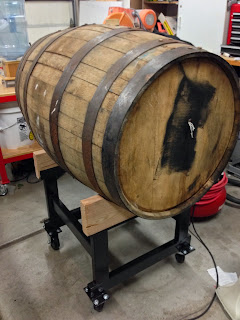Tart of Darkness Experiment
>> Sunday, December 22, 2013
14 oz Briess Crystal 60L
14 oz Flaked Oats (steep in BK)
6.7 oz Briess Roasted Barley
5.1 oz Briess Chocolate Malt
28.3g Aged debittered hops (60 min)
Oak cubes in secondary
Mash at 155F for 60 min. 90 min boil. Ferment at 68F
Update 12/27/2013
The brew session went well back on 12/22; no issues, hit the target gravity, pitched at 66F and warmed to 68F overnight. That said, I might have an issue with this beer. The picture of my Berliner Weisse from April shows a nice krausen within 24 hours of pitching. After five days, I still haven't seen any sign of a krausen in the ToD Experiment. This has me a little worried. It's too early to panic, but I think I'll pull a sample before pitching the Roeselare to check the gravity and see how it's progressing. I tasted the starter wort before pitching and it had the same light lemony tartness as the BW starter. The aroma was a little bit different on this one...kind of musty but not smelling like dirty feet or anything like that.
Update 12/30/2013
So some sad news today, I checked on this brew and there were tiny spots of mold starting to grow on top. It never showed any signs of krausen from pitching the lacto. It was definitely mold and not a pellicle. I suspect I got a bad/mishandled lacto culture with limited viability. So essentially the lacto cell count was lower than expected which allowed the mold to take hold and start growing. There was a slight gravity change but there is no detectable sour aroma and only a very, very subtle tartness in the flavor. It was so subtle that I probably wouldn't have noticed it if I wasn't looking for it. I've never had mold before. I decided to go ahead and rack from under the the mold rafts and pitch the Roeselare to see what happens. Best case scenario, I'm probably looking at 6-12 months for it to finish; worst case, this will be a dumper.
Update 12/31/2013
Better news today, as usual the Roeselare has taken off like crazy. I added a blowoff this morning to hopefully avoid making a mess. I've heard people comment that Roeselare is a slow starter. I've only experienced that once and I think that was because it was an older sample (6+ months). Every other time I've used it, it has been very active within 24 hours of pitching. It usually calms down after a few days then gets fairly active again after a couple weeks then slows down again for the long haul.
Update 1/7/2015
I pulled a sample today. This one turned out well with some nice chocolate notes to accompany the mild tartness. It's definitely not as complex as the club version that went into the barrel, but it's pretty good. I think I may add some bourbon soaked oak cubes to try to give it a bit more complexity.
Update 6/2/2015
I added bourbon soaked oak cubes a while back but this beer is still lacking a lot of complexity compared to the group version. Sourness level is fairly low as well. Not a bad beer but knowing how good the group version turned out, this one pales in comparison.








































